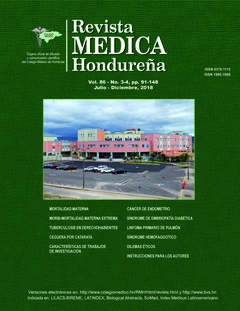Mortalidad y morbilidad materna extrema, Hospital Escuela Universitario 2015: estudio caso-control
DOI:
https://doi.org/10.5377/rmh.v86i3-4.12171Palabras clave:
Indicadores de morbimortalidad, Morbilidad, Mortalidad materna, Near miss, SaludResumen
Antecedentes: En 2015, el Hospital Escuela Universitario (HEU) registró una tasa de mortalidad materna de 136/100000 nacidos vivos. Objetivo: Determinar los factores asociados a mortalidad materna en casos de morbilidad materna extrema (MME), HEU, Tegucigalpa, 2015. Metodología: Estudio caso-control. Se utilizaron criterios OMS (2009) para definición de casos (muertes) y controles (MME). Se estimaron proporciones, razón de disparidad (OR) e intervalo de confianza de 95% (IC95%); p<0.05 se consideró estadísticamente significativo. Resultados: Las proporciones identificadas fueron MME 6.1% (990/16,209) y muertes por MME 1.7% (17/990). Se evaluaron 17 casos de muerte materna y 51 controles de MME. En casos y controles respectivamente, se identificó edad promedio 30 (16-34) y 25 (14-44) años, primíparas 52.9% (9) y 49.0% (25), información incompleta sobre control prenatal 70.6% (12) y 45.1% (23); patologías registradas: trastornos hipertensivos 58.9% (10) y 54.9% (28), sepsis 29.3% (5) y 11.8% (6), hemorragia masiva 11.8% (2) y 25.5% (13). Los factores asociados significativamente a mortalidad: Edad ≥19 años (OR5.2, IC95%1.1-25.4, p=0.02), Glasgow <8 (OR6.4, IC95%1.5-26.7, p=0.005), hospitalización en Sala Emergencia Medicina Interna (OR11.5, IC95%3.2- 41.2, p=0.00004). Sepsis e internamiento en UCI, demostraron tendencia a p<0.05. Discusión: La proporción de MME identificada es superior a la informada en otras regiones del mundo. El análisis de los factores asociados fue limitado por datos incompletos. Las pacientes deben hospitalizarse y recibir atención adecuada y oportuna antes de que el deterioro sea irreversible. Mejorando el sistema de vigilancia, el análisis de las condiciones de MME podría usarse como indicador de calidad del cuidado materno.
Descargas
383




